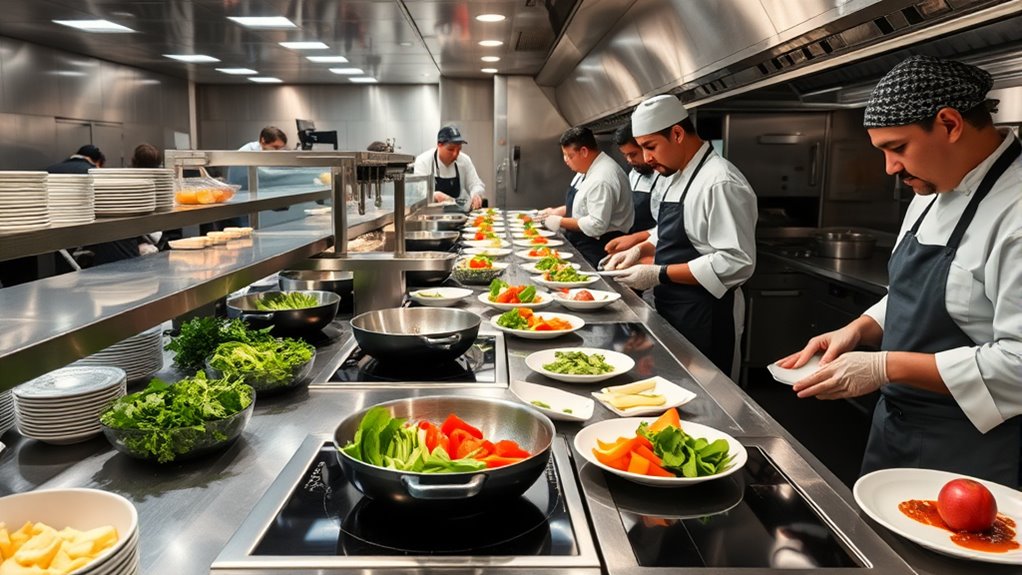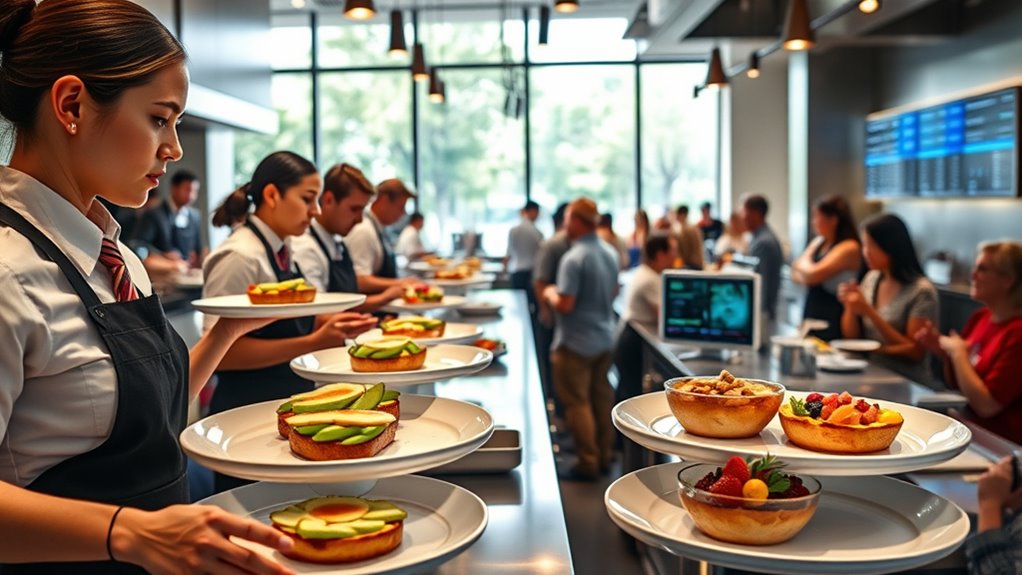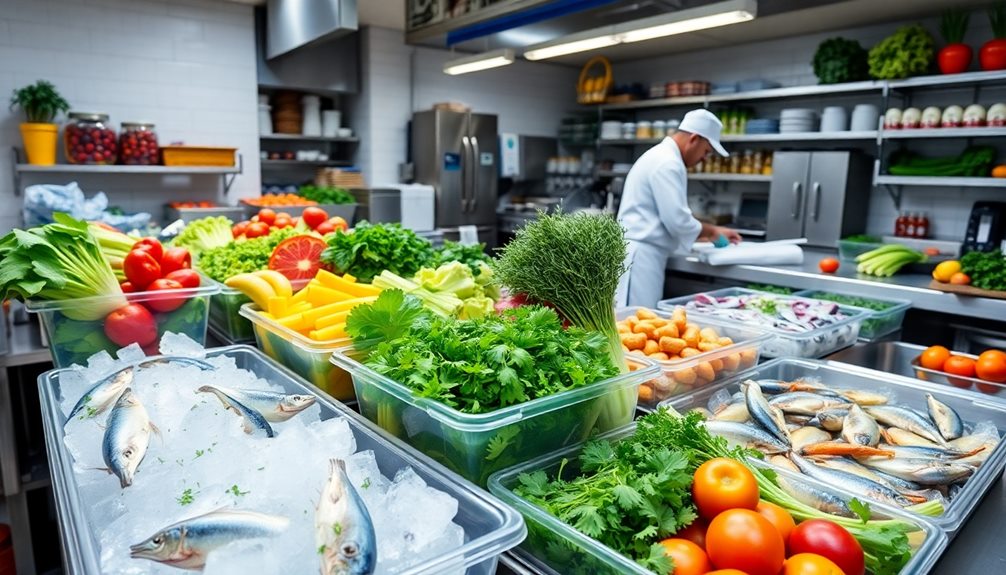To keep your weekend brunch running smoothly, optimize your menu with a few quick-to-prepare dishes, and organize ingredients for fast access. Set up stations and pre-assemble common items to speed service, and use efficient order systems to minimize delays. Communicate openly with guests about wait times, offer alternative seating, and encourage pre-orders. Track bottlenecks and adjust workflow on the fly—if you explore further, you’ll find even more tips to boost your turnover.
Key Takeaways
- Optimize menus with quick-prep, popular dishes sharing ingredients to reduce wait times and simplify kitchen operations.
- Organize ingredients and prep stations for rapid access, pre-portion items, and maintain a clutter-free workspace.
- Use real-time order tracking and clear communication to prevent misorders and streamline staff workflows.
- Clearly communicate wait times to guests, offer alternative seating, and engage them with pre-orders or small entertainment.
- Monitor station bottlenecks during peak hours, adjust workflows promptly, and reassign staff to maintain a smooth flow.
Streamlining the Menu for Speed and Simplicity

To keep weekend brunch running smoothly, simplifying the menu is essential. You want to focus on a few standout dishes that can be prepared quickly without sacrificing quality. Limit your options to avoid overwhelming your kitchen staff and to speed up order fulfillment. Clear, straightforward offerings help your team work efficiently, reducing wait times and preventing bottlenecks. Prioritize dishes that share ingredients or cooking techniques to streamline prep work. Consider offering a small selection of popular items rather than a large, complex menu. This approach not only speeds service but also makes it easier for customers to choose. A simplified menu keeps the operation tight, ensuring your brunch runs seamlessly and customers leave satisfied. Paying attention to spiritual energy can also foster a more positive atmosphere in your establishment, enhancing both staff morale and customer experience.
Optimizing Table Turnover With Clear Seating Strategies

Have you ever noticed how long it takes for tables to clear during busy brunch hours? Clear seating strategies can speed up turnover and maximize revenue. Start by clearly marking reserved sections for large groups and walk-ins to prevent confusion. Use visual cues like signs or floor decals to guide guests to available tables quickly. Encourage your staff to seat guests promptly, aiming for efficient use of space without making guests feel rushed. Consider implementing a waitlist system that updates in real time, so your team can prepare tables in advance. Communicate with servers to prioritize clearing and resetting tables as soon as guests leave. Incorporating rustic decor elements can also create a welcoming atmosphere that encourages smooth transitions between guests. By creating a seamless flow from guest departure to new seating, you’ll keep the pace fast and the line moving smoothly.
Prepping Ingredients and Stations for Rapid Service

To keep your brunch service running smoothly, you need to organize ingredients efficiently and set up stations thoughtfully. Pre-assembly techniques can save time and reduce errors during busy hours. Focus on streamlining these processes to guarantee rapid, seamless service. Incorporating effective use of pimple patches in your skincare routine can also promote clearer skin, reducing the need for last-minute fixes.
Efficient Ingredient Organization
Efficient ingredient organization is essential for a smooth and rapid brunch service. You want everything accessible, clearly labeled, and grouped logically. Start by arranging ingredients in the order they’ll be used, minimizing movement and search time. Use prep stations or trays to hold pre-measured portions, so you can grab what you need quickly. Keep frequently used items at eye level or within arm’s reach. Store perishables in designated zones, ensuring they stay fresh and are easy to locate. Use clear containers with labels to avoid confusion during busy moments. Regularly check stock levels and replenish ingredients as needed, avoiding last-minute scrambles. Incorporating checklists can help ensure all necessary items are prepared and organized before service begins. This setup reduces delays, keeps the line moving, and helps you serve high-quality dishes under pressure.
Station Setup Strategies
Setting up your stations strategically guarantees quick, smooth service during busy brunch hours. Begin by placing frequently used ingredients within easy reach, minimizing movement. Organize tools, utensils, and garnishes logically, grouping similar items together to speed up assembly. Use clear labels to identify stations and contents, reducing confusion. Pre-portion ingredients into manageable amounts to streamline plating and reduce waste. Set up separate stations for hot, cold, and prep work to prevent bottlenecks. Ensure each station has everything needed—cutting boards, knives, towels—so staff aren’t searching for tools. Maintain a clean, clutter-free workspace to improve efficiency. Regularly check stock levels and replenish ingredients before they run out. Auditory processing skills can also be enhanced through consistent communication and feedback among team members, ensuring everyone stays aligned during service. Well-planned stations keep your team moving swiftly and help deliver a seamless brunch experience.
Pre-Assembly Techniques
Pre-assembling ingredients and organizing your stations before service begins can substantially cut down on prep time and keep the flow smooth. Start by identifying key ingredients that can be prepped in advance, such as chopped vegetables, cooked proteins, and assembled toppings. Next, set up station zones with everything in reach, including utensils, garnishes, and condiments. Finally, implement these three pre-assembly techniques:
- Pre-chop and portion ingredients for quick assembly.
- Pre-cook items like bacon or sausage to reheat efficiently.
- Pre-assemble common dishes or components, such as breakfast sandwiches or salads. Additionally, understanding the importance of projector technology can help in creating an ideal environment for presentations or entertainment in your setup.
Implementing Efficient Order Management Systems

Implementing an effective order management system is essential for streamlining your weekend brunch operations. It helps you track orders accurately, reduce errors, and speed up service. Choose a system that integrates seamlessly with your POS and kitchen displays, ensuring real-time updates. Clear communication channels between servers and kitchen staff are critical to prevent misorders and delays. Automate repetitive tasks like order printing and status updates to save time. Consider using digital tablets or apps that allow servers to input orders directly, minimizing handwritten mistakes. Regularly review your system’s performance and gather staff feedback to identify areas for improvement. Incorporating real-time updates can further enhance efficiency and prevent confusion. A well-organized order management process keeps your brunch running smoothly, enhances guest satisfaction, and maximizes table turnover during busy weekends.
Training Staff for Multi-Tasking and Agility

To keep up with the fast-paced nature of weekend brunch service, you need to train your staff to be both multi-taskers and agile. Start by teaching them to prioritize tasks efficiently, so they can handle multiple tables and orders simultaneously. Next, focus on cross-training your team across stations, ensuring everyone can step in wherever needed. Finally, encourage quick decision-making through simulated scenarios that mimic real rushes. Incorporating interactive learning toys into training can further enhance their problem-solving and adaptability skills. Here’s how to boost their agility:
- Practice multitasking drills during training sessions
- Rotate staff between different roles regularly
- Conduct timed challenges to improve response speed
Managing Wait Times and Guest Expectations

Managing wait times and guest expectations is essential to creating a positive brunch experience, especially during busy weekends. Clear communication helps guests feel valued and reduces frustration. Use real-time updates via tables or digital screens to inform guests about wait times and estimated seating. Offer alternatives like bar seating or small plates to keep guests satisfied while waiting. Consider providing complimentary drinks or snacks as a gesture of goodwill to ease tension. To help you stay organized, here’s a quick overview:
| Strategy | Implementation | Benefits |
|---|---|---|
| Clear Communication | Announce wait times openly | Reduces guest anxiety |
| Alternative Seating Options | Bar or patio seating | Keeps guests comfortable |
| Guest Engagement | Offer menus for pre-ordering or drinks | Enhances experience |
| Real-Time Updates | Digital screens or apps | Builds trust and transparency |
Reviewing and Adjusting Workflow During Service

As service advances, monitor peak activity levels so you can spot when things get busy. Identify any bottlenecks quickly and figure out how to smooth out the workflow to keep everything flowing. Make certain to communicate any adjustments clearly to your team to ensure everyone stays on the same page. Additionally, understanding safety in shark-infested waters can help you implement protocols that maintain a smooth operation even in challenging conditions.
Monitor Peak Activity
Have you ever noticed how the busiest moments during brunch service call for quick, decisive adjustments? To stay ahead, you need to monitor peak activity closely. Keep an eye on these key indicators:
- Table Turnover Rates: Track how fast tables are clearing to anticipate when to prepare for new guests.
- Order Pace: Watch how quickly orders are coming in and being fulfilled, so you can redistribute tasks if needed.
- Staff Load: Observe staff workload to ensure no one’s overwhelmed, reassigning duties as necessary.
- Sound Levels and Noise can also serve as Rhythm Failure indicators, helping you gauge overall activity and adjust staffing or music volume accordingly.
Identify Bottleneck Points
Identifying bottleneck points during service allows you to make real-time adjustments that keep the flow smooth. Watch for stations where orders pile up or delays occur, like the kitchen, bar, or serving stations. Pay attention to staff movement—clogs often happen when tasks aren’t evenly distributed. Use visual cues, such as lines forming or staff looking overwhelmed, to spot issues early. Once you recognize a bottleneck, quickly assess whether additional staff are needed or if certain tasks can be streamlined. Flexibility is key; shifting responsibilities or adjusting workflows on the fly helps prevent backups. Regularly monitor the entire operation, staying aware of where delays tend to happen, so you can intervene promptly and keep service running seamlessly.
Communicate Adjustments Clearly
Effective communication is essential when reviewing and adjusting workflow during service to make certain everyone is aligned and aware of changes. To do this effectively, focus on these key steps:
- Clearly state the change: Be specific about what’s being adjusted and why.
- Use concise language: Avoid jargon or ambiguity that could cause confusion.
- Confirm understanding: Ask team members to repeat or summarize the adjustment to ensure clarity.
Frequently Asked Questions
How Can Technology Further Enhance Brunch Service Efficiency?
Technology can considerably boost your brunch service efficiency by streamlining orders and reducing wait times. With digital POS systems, you can quickly send orders to the kitchen, minimizing errors. Mobile apps allow customers to place orders ahead, speeding up service. Additionally, inventory management software helps track supplies in real-time, preventing shortages. By embracing these tools, you guarantee a smoother, faster brunch experience, keeping customers happy and your operations running seamlessly.
What Are Common Mistakes to Avoid During Peak Brunch Hours?
Imagine juggling flaming torches during a busy show—you need focus and timing. During peak brunch hours, avoid overloading your staff or rushing orders, which can lead to mistakes. Keep communication clear and streamline your process to prevent chaos. Don’t forget to monitor wait times and replenish supplies promptly. Staying calm, organized, and attentive guarantees the show goes on smoothly, leaving guests satisfied and coming back for more.
How Do Staffing Levels Impact Turn-And-Burn Performance?
Your staffing levels directly impact your turn-and-burn performance during busy brunch hours. If you don’t have enough staff, service slows down, orders pile up, and customers become unhappy. Overstaffing, however, can lead to wasted resources. It’s vital to strike a balance—adequate staffing ensures quick service, smooth operations, and a positive experience for your guests. Regularly assess your peak times to adjust staffing and keep everything running efficiently.
What Are Effective Ways to Handle Last-Minute Reservations or Walk-Ins?
When last-minute reservations or walk-ins arrive, you should stay flexible and prioritize clear communication. Quickly update your team on new arrivals, and consider adjusting seating arrangements to maximize capacity. Offer waitlist options and estimated wait times to keep guests informed and satisfied. You can also prepare a few quick-service items to serve those waiting. Staying calm and organized helps guarantee a smooth experience for everyone, even on busy, unpredictable days.
How Can Feedback Be Used to Improve Weekend Brunch Operations?
They say, “feedback is the breakfast of champions.” You can use feedback to improve weekend brunch operations by actively listening to customer comments and staff insights. Implement changes based on recurring issues, such as wait times or menu preferences. Regularly review feedback, train staff accordingly, and adapt your strategies. This continuous improvement guarantees a smoother, more enjoyable experience, turning customer suggestions into opportunities for growth and excellence.
Conclusion
By mastering these tips, you’ll turn your weekend brunch into an unstoppable, clock-crushing machine. Imagine guests leaving dazzled, raving about your lightning-fast service while your staff moves like a well-oiled, brunch-making superhero team. With streamlined menus, flawless seating, and turbocharged prep, you’ll dominate the brunch scene so completely that even your competitors will be reaching for their coffee, trying to catch up. Get ready to transform your brunch game into an unstoppable, time-defying frenzy!









